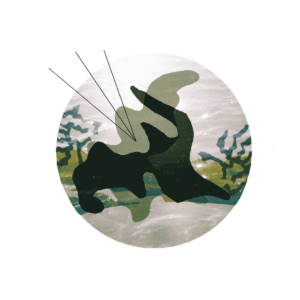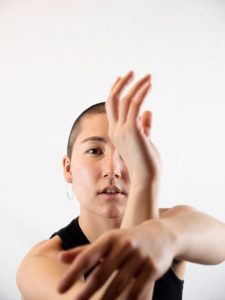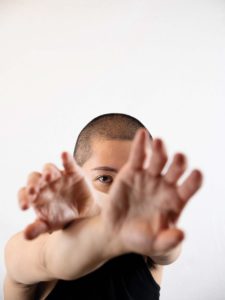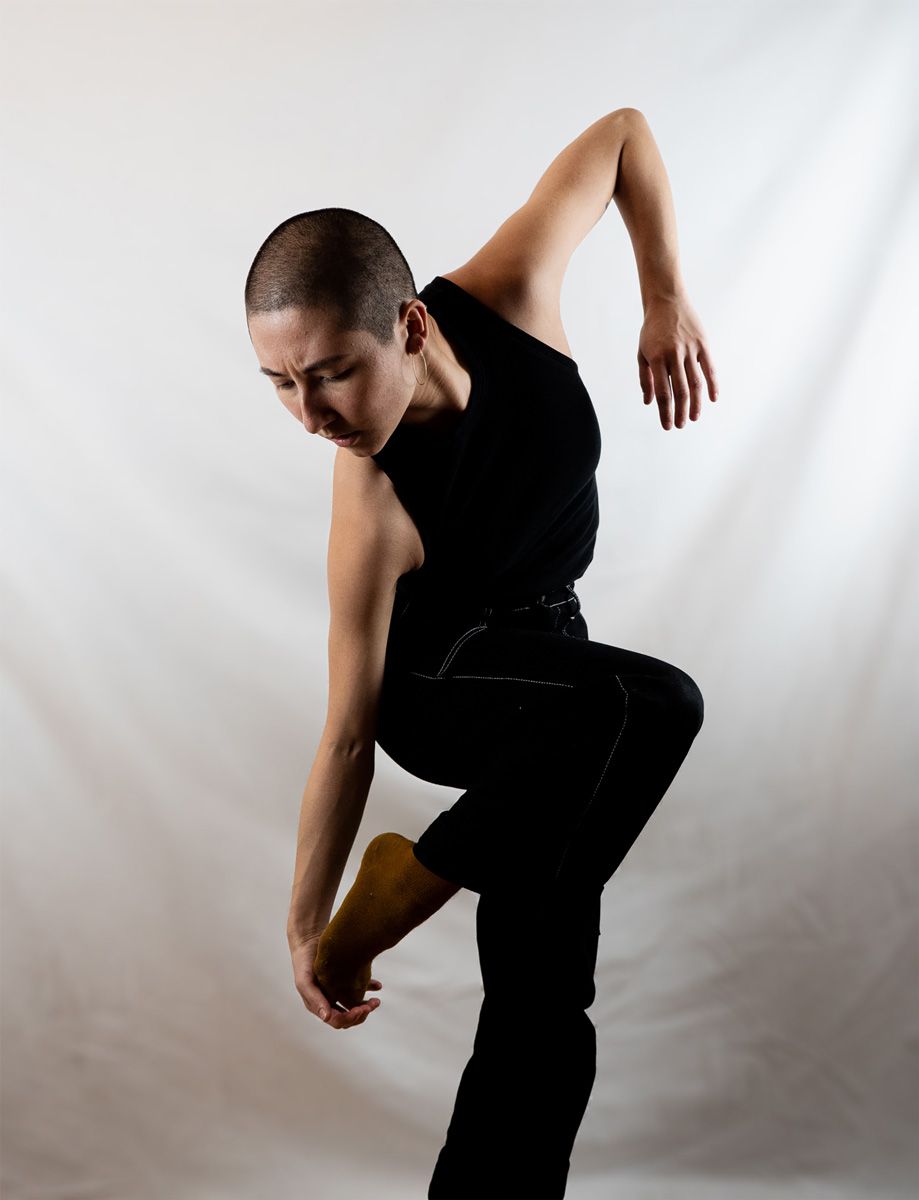Pitch black. One tiny, warm glimmer of a paper box shines in the room as if it was the first light in the world. The beginning of everything. A human arm is timidly reaching out of the box, reaching for the sky, trying to stretch out as far from the tiny box as possible to feel the world. Going back in the box, it comes out again with a blank piece of paper in its palm, tossing it into the stage. The soft sound of the paper is soothing, then, another one is presented to the world. This time the white paper is with a letter — の (no) — stuck on the side of the box. Then the third paper — 私 (watashi) — combined to mean ‘mine.’ Finally, Shion Skye Carter herself crawls out to the box, and weak beams of lights brighten the room — turning the stage into her dear Japanese house complete with rectangle patterns on the floor. Setting a platform for her self-journey.
Shion Skye Carter is a Vancouver-based dance artist, who is also first-generation Japanese. She moved to Vancouver at the age of 6 from Tajimi of Gifu prefecture, Japan. Her dance performance often is often integrated with other arts forms — aiming to explore her multiethnic and queer identities. In her performance, for her performance, Residuals (住み・墨.) Japanese calligraphy was used in the exploration of her personal, and ancestral connection to Japan. Shion told me that calligraphy held a personal connection to her, as she practiced it as a child in Japanese school. She was reconnected with this tradition in 2019 when realizing the depth of this art in terms of the body movement it requires. It provoked her to bring the motion, and Japanese characters, onto the stage. This Calligraphy-infused solo dance project was first performed at multiple sites, including its premiere at Tangente in Montreal, and is planned to premiere in Vancouver at the Scotiabank Dance Centre in September 2022.

Many people in this multi-ethnic city can perhaps relate — living as first-generation in a different country (and culture) since a childhood does not come easy. “I felt a lot of confusion and, I guess, sort of cultural displacement too. I did feel a lot of tension growing up with certain parts of Japanese culture that I just could not understand.[…] A lot of traditional parts of the culture, or social expectations, I couldn’t agree with, and I couldn’t understand. I felt this friction,” she says. That friction is reflected in her dance movements — filled with many tensions — including the paper box scene described from. Residuals (住み・墨.) In showing only parts of her body uncannily, the fragmented body starts to represent a person broken into different pieces — indirectly hinting at an internal fight for a coexistence of two seemingly juxtaposed identities, being queer and Japanese. Queerness is one of many topics that are underexplored in Japan, and its lack of understanding in this matter deepened a gap between her and her family. She felt nervous to come out to her mother, and still feels challenged to talk about it to her relatives in Japan. To me, this piece highlights the problems of old conservative views in Japan from the perspective of someone who has both a background in Japanese culture and Western culture.

Even before this project, Shion noticed the influence from experiences of living in both Canada and Japan during her discovery of her own art style. She decided to explore this through choreography — noticing the presence of her Japanese identity at the base of her movements. For example, moving around in a low posture reflected the lifestyle in Japanese traditional houses, which are relatively low to the ground and outfitted with shorter furniture requiring people to live close to floors. This muscle-memory provoked her familiarness to Japanese culture. In one of her characteristic scenes, she crawls around the stage under rectangle light-patterns and an image of an ink drop on the floor. The rectangle shapes on the floor are to show the layout of the house — and she dances about the life habits and memories associated with each room. This scene was inspired by a brush stroke as well. Shion draws Japanese characters in the air and on the floor with her body, like 中身 (nakami), meaning contents inside of something, which explores how different surfaces can be a writing platform. Writing the same characters 中身 over and over through this scene by multiple dance moves, it simulated her memory of the calligraphy class where she needed to practice one character many times.
Shion also noticed an unconscious tendency of using elements of her grandfather throughout her dance process and in her movements. The costumes she chose, ones which made her the most comfortable, ended up unintentionally resembling what her grandfather used to wear. The black shirt and pants were similar to his work uniform another coincidental connection to this project. Her connection with him is living inside her identity, and her performances. One of the unforgettable moments in Residuals (住み・墨) is one in which she posed, squatted down a little and mimicked the motion of smoking cigarettes — gesturing to what she saw her grandfather do everyday. She told me that she felt the furthest from him in the family, as he passed away when she was 12. It seems that her attempts to approach the culture that became distant during her years in Vancouver has, in a wraparound way, also reminded her of her distance from her grandfather. “Thinking so much about my grandparents’ house and the domestic space, I think his spirit came to me. I feel a lot closer to his spirit now, and I didn’t expect that to happen […] that distance is not that far anymore.” 
One soft light warmly spotlights Shion wrapped in white dress made of calligraphy papers, and we hear a subtle sound of the papers swaying and touching each other as she moves across the stage smoothly. Her gentle voice goes along her fluid movement, describing her memory tracing the way she lived in the grandparents’ house. The consistent tension in the dance suddenly softens in this last scene, which showed a relief at finding herself within Japanese culture as well as connected with her family again. “[This project] opened up a lot of doors for me by doing some research,” She said. It had required her to ask her mother and her grandmother many questions about Japanese heritage, which themselves became good opportunities for open conversation. Residuals (住み・墨) beautifully shows one’s journey of self-discovery, the struggle to reclaim it and make it into your own. Art that does not compromise the idea that there is only one way to be and feel Japanese.


